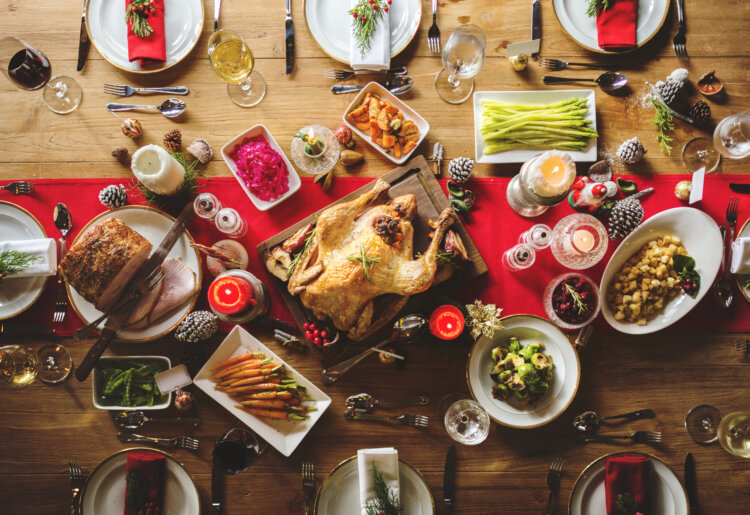
As parents of a multiracial child, my husband and I often have debates about what family and cultural traditions to pass down to our son. Midnight mass on Christmas eve or Christmas morning mass? Should we have Vienna sausages and kraut on New Year’s Day, or long life noodles? Is Chinese (Lunar) New Year even worth celebrating since my extended family is so far away?
Ethnically, I’m mostly Chinese with a hint of Dutch and Indonesian-Malay. My husband is half Pakistani and half Caucasian, but he was adopted by white parents.
We are not alone. The Pew Research Center reported that one-in-seven U.S. infants (14 percent) were multiracial or multi-ethnic in 2015, nearly triple that in 1980.
Despite our deliberations, I know one thing to be true—traditions are important. And in my opinion, food is the perfect vehicle for passing them on. Whether it’s everyday cooking or holiday meals, I like to reflect on my own multicultural childhood.
I grew up in an Indonesian-Chinese family living in Singapore. And my mother was determined to champion our family’s traditions and culture, and did so with fervor.
I can still remember turning up my nose at many of the traditional Indonesian foods. Instead of hot dogs, fish sticks and French fries, my mom tried to feed me vegetables with peanut sauce (gado gado) that was full of yucky, green stuff (can you blame 5-year-old me?), and sour soup that was, well, sour. But she never gave up, and these dishes kept reappearing. Every time Mom pulled spring roll wrappers out of the freezer, I knew to run and hide or else I’d be roped into folding lumpia.
At Christmas, golden rice (nasi tumpeng), turmeric fried chicken (ayam goreng kuning), braised curry beef (rendang) were laid side by side with Dutch meatloaf (galantine), honey-baked ham and a bûche de Noël. During Chinese New Year, my parents would hustle us reluctant children to our grand-aunt’s house. Every year, we had steam-boat (or hot pot), a favorite Chinese-Singaporean reunion dinner meal.
Everything I ate became a part of me—our Dutch colonial past, the Indonesian customs my mom instilled in us and the rites of our adopted homeland.
Now that I’m a mother raising a son who can claim at least four ethnicities, I realize how invaluable it is to have my family’s foods and traditions in my head and in my hands to share with him. Whenever I fold spring rolls with him or watch him scarf down curry beef over rice, I whisper a “thank you” to my mom.
Regardless of family history, food can be used as a valuable tool to pass down family traditions and culture. Whether you’re a Korean adoptee raised in a German-Irish family, or a Pakistani-American man married to an Indonesian-Chinese woman, everyone can have family traditions to share.
Regardless of family history, food can be used as a valuable tool to pass down family traditions and culture.
Mind you, I haven’t taken everything wholesale from my parents. Over the years, I’ve mixed and matched, tweaked this and that, to come up with food traditions—both holiday and everyday ones—that fit with my own family.
When it comes to American holidays, I take my cue from my husband’s family. The daughter and spouse of military men, my mother-in-law has picked up traditions from her Pennsylvania Dutch mother as well as from places she’s lived over the years. Her must-do’s include everything from serving special-occasion Spanish paella and brunching on native Hawaiian koa wood platters (yes, we own a set!).
We always have turkey on our Thanksgiving table but perhaps marinated in soy sauce and/or spiced with Sichuan peppercorns and star anise. Instead of watery canned pumpkin, I’ll roast a whole kabocha squash, a sweeter and stodgier Japanese variety, and scoop out the pulp for the filling. By hook or by crook, the Best (my M-I-L’s maiden name) family orange-cranberry relish is a must, as well as my husband’s beloved pumpkin pie. And here’s the best part: My husband, who normally avoids cooking like the plague, will bake the pie with our son!
While my mother baked cakes and stuffed breads, she never baked cookies. So baking Christmas cookies was new to me. My mother-in-law wasted no time introducing my son to Mexican wedding cookies and peanut butter blossoms: the baking and eating of. Now, my son and I bake cookies every year to give to friends and neighbors. I usually like to add a twist to classic cookies, whether it’s adding matcha powder or subbing pandan (a Southeast Asian herb used as flavoring) for vanilla. Several years ago, my mother-in-law gave me a pizzelle maker so that these delightful anise-scent wafers could enter the rotation.
Growing up, we always celebrated Chinese New Year with the extended family on New Year’s Eve. Even though that’s not always possible since we live on opposite coasts, I still try to celebrate Chinese New Year with a celebratory meal. No matter how simple, the meal must include some lucky foods. And we don’t necessarily have it on Chinese New Year’s Eve. Plus, I might invite a family or two and introduce them to Chinese culture.
Whether it’s baking Nana’s cornflake-topped kugel or having a dumpling breakfast on New Year’s morning, food traditions can play an important part in reinforcing family values and beliefs. In the end, it doesn’t matter what the traditions are, but rather the effort and the memories and warm-and-fuzzies they instill.
For recipes, visit the author’s blog Pickles and Tea: Adventures in Asian American Cooking.


Grok Nation Comment Policy
We welcome thoughtful, grokky comments—keep your negativity and spam to yourself. Please read our Comment Policy before commenting.